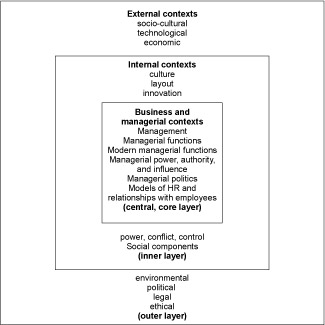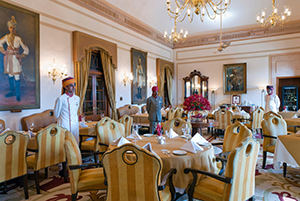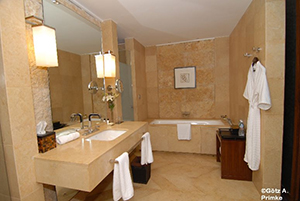Outer contexts
Various frameworks with associated acronyms have been created to help put some analytic order on the complexity of the environment. A well-known one is PESTLE:
- Political
- Economic
- Social
- Technological
- Legal
- Environmental.
Another acronym much used in the study of the external environment for HR is ‘STEEPLE’. This refers to the factors shown in Table 1:
| Field | Examples of key drivers of strategy |
|---|---|
| Socio-cultural | Demography by size, age, other social characteristics and geographical distribution, working population, gender, ethnicity, education and training, religion, social values and beliefs |
| Technological | Information and communication technologies, biotechnology, medical advances, nanotechnology, robotics, technological change, research and development |
| Economic | Macro-economic policy, markets and prices, price levels, global trends, market structures, size of firms, profits, public spending, taxation, consumption and investment spending, wages and salaries, public services, imports and exports, exchange rates, balance of payments, employment and unemployment, labour and capital markets |
| Environmental | Global warming, conserving natural resources, sustainable development, pollution, carbon footprints, protecting the eco-environment |
| Political | Party politics, government, opposition, public administration, public policy, devolved assemblies, local government, pressure groups, public opinion, EU institutions, international organisations |
| Legal | Contract law, employment law, health and safety, consumer protection law, company law, codes of practice, regulatory bodies, the legal system and the courts, the European Court of Justice |
| Ethical | Balancing stakeholders interests, ethics in the workplace, ethical business relations, ethical production, ethical consumption, ethical purchasing, promoting employee welfare, human rights, corporate social responsibility |
Aspects of each of these acronyms are indicated in Figure 2:

Activity 3: Steeple analysis
Part 1
You would find it helpful if you now tried a short STEEPLE analysis of your own.
EITHER: Use the space below to perform a STEEPLE analysis on an organisation you know well:
Part 2
OR: If you do not have an organisation to use, compare the following two case organisations and answer the question that follows in the space provided.
A high-end hotel leisure resort
The Grand Hyatt, Goa [Tip: hold Ctrl and click a link to open it in a new tab. (Hide tip)]

The company website states:
Grand Hyatt Goa is set to take its place as Goa’s largest and most sophisticated luxury conference and wedding resort.
Grand Hyatt Goa brings the ultimate event experience to the dynamic meeting and weddings scene, with an overall banquet facility of over 3000 sq m.
The Grand Hyatt brand has long enjoyed a well-earned reputation for excellence in the field of banqueting and catering. A professional and attentive team oversees many successful events and ensures that catering and conference needs are met to the client’s satisfaction. To further enhance its position as a leading conference venue, a dedicated events team has been established and will provide and maintain the highest standards of excellence and personalised service for our delegates and organisers.
The versatile function rooms are located across two floors, and include the elegant Grand Ballroom. Six functions rooms are on the ground level with a pre-function area ideally equipped to hold receptions. The lobby level also houses two meeting rooms and two board rooms.
Grand Hyatt makes available a full complement of meeting aids and technical assistance, which includes an impressive inventory of state-of-the-art equipment for high-speed Internet access and video conferencing. Experienced professional technicians can assist with the set-up and operation of each audiovisual programme.

Club 18–30 mass-market travel

Described as ‘cheap clubbing holidays’, the advertisement to recruit holiday reps for this company states:
Do you got [sic] what it takes?
Being one of our Club 18–30 holiday reps is a job like no other! It’s definitely not for the faint hearted, you’ll need to have a great personality, awesome communication skills and enough stamina to keep you going from morning to night!
Compare the strategies of these two companies in so far as they can be inferred from their marketing. Using a STEEPLE analysis as a framework, what implications would you think that these contrasting strategies would carry for the practice of human resource management?
Write your notes in the space provided below.
Discussion
The two contrasting cases of the Grand Hyatt and Club 18–30 would seem to carry a range of implications for HR, and the STEEPLE framework can help to order your thinking about these differences. So, for instance, the social/cultural contexts of the two organisations are likely to be dramatically different as they attract diverse clientele with divergent cultural expectations and interests. The leisure pursuits on offer would be different and the kind of staffing arrangements needed to facilitate these different cultural interests would be distinct.
The brief person specification of the ideal Club 18–30 reps indicate the expected behaviours and interests of the staff appointed to these roles. The technology offered by these two companies will vary between a high-investment in facilities in the Grand Hyatt and thus a need for specially trained staff to offer the services built around these technologies (fine dining, cocktail bars, spas and so on) in contrast to the low-tech, low investment in buildings associated with Club 18–30 where the emphasis is upon trips with considerable alcohol consumption.
The political, economic and legal contexts will vary depending on which country these international companies operate within. Host country contexts will present widely divergent challenges. Luxury hotels may sit uneasily in local contexts where there is extreme poverty. Local politics may require a certain proportion of labour to be locally sourced. The more mass-market end of the tourist industry, as exemplified by Club 18–30, will face its own challenges in that expectations and behaviours of clients may conflict with local values and norms. And again there will be dilemmas about the relative use of local versus imported labour.
